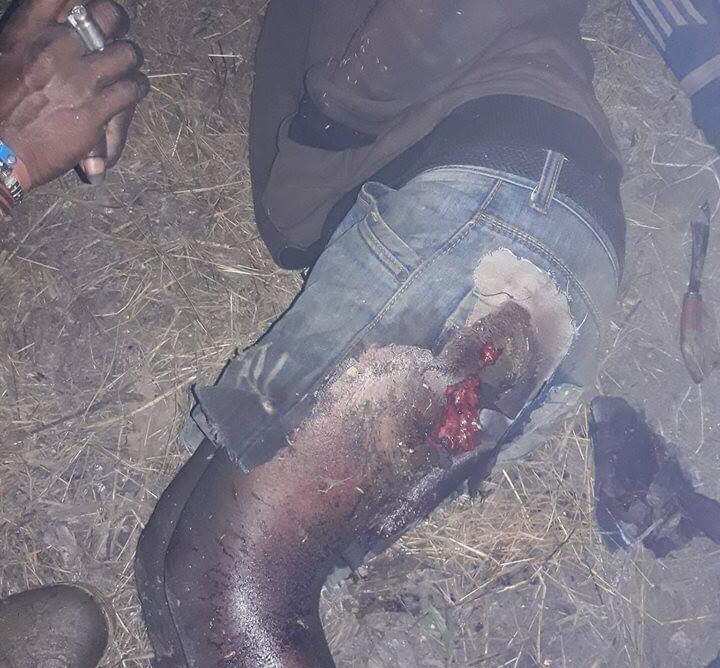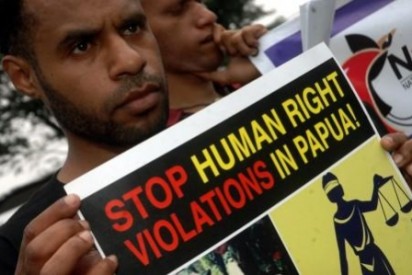Indonesian military use chemical weapons in West Papua
December 23, 2018

A villager wounded in the Indonesian attack in the West Papua central highlands.
Article originally published by The Saturday Paper
There are burns around the wounds. The flesh appears to have been torn open or burrowed into, the victims’ clothing melted or cut away. At least seven are dead. Thousands more have fled into the hills.
These are the first images of a major operation being conducted by the Indonesian military in the central highlands of West Papua. Other photographs show yellow-tipped bombs, collected by villagers. Some weapons appear to be white phosphorus, banned under international law for use of this kind.
White phosphorus is considered both an incendiary weapon and a chemical weapon. It burns through skin and flesh, down to the bone. It cannot be extinguished. The only way to save a person hit with it is to submerge them in water and attempt to remove the phosphorus. Many die from internal burns. Others from the phosphorous absorbed into their bodies, which can cause multiple organ failure.
A military source confirms the weapons “appear to be incendiary or white phosphorus”. The source says “even the smallest specks burn through clothing, skin, down to the bone and keep on bubbling away. I have seen it up close and personal and it’s a horrible weapon.”
One Indonesian soldier said they were firing a type of gas on the villages. “It is an explosion, but a type of gas.”
The photographs were taken between December 4 and 15. Three of the dead are from a village called Mbua, in the Nduga region. Their names are Mianut Lokbere, Nison Tabuni and Mendus Tabuni. Four others were killed in a village called Yigili. “It was happened on December 15, 2018,” an Mbua man told The Saturday Paper. “At 11.25 local time. They are dead because Indo army bombing them from the chopper. It’s because of airfare.”
One image shows a man swathed in wet bandages, strips of cloth really, in an attempt to alleviate his pain from the burning object still inside him. Another shows a woman beside the grave of someone killed in the bombing and some unexploded shells carefully collected by the villagers. Others show the bodies of the dead.
Sources say at least four villages have been attacked, from the air, from artillery and from ground troops. The Indonesian army has sealed off the area. Church and local government officials cannot get in to investigate or help those sheltering in the jungle, some of whom may be wounded.
A colleague looks at one picture and asks: “Is that a face?”
The troops were lined up at the airport in Abepura, which serves the West Papuan capital of Jayapura. There were large backpacks and weapons casually left all over the place. The scene was broadcast on Indonesian state television. They were going to the jungles of the West Papuan highlands, ostensibly to retrieve the bodies of the 31 Indonesian road builders who had been killed by local villagers. It was presented as a humanitarian act. But like everything in Papua, nothing was really as it seemed. In reality, the troops were going in, heavily armed and with full air support, to teach the West Papuans a lesson. They were going in to kill. They would fly to Wamena, the main town in the highlands. From there, helicopters would take them to the remote villages inhabited by the Nduga people.
The incident started on December 1, several days before the troops went in. December 1 is the day West Papuans mark as their declaration of independence from the Dutch in 1963. Indonesians began occupying West Papua the following year and in 1969 formally annexed the territory.
On December 1, the West Papuans raised their flag, the Morning Star. Such events are a source of great tension with the Indonesians. This year, Indonesian troops arrested more than 500 for attending flag-raising ceremonies in the capital Jayapura, as well as in regional centres and places such as Surabaya, where Papuan students held a protest before the arrests.
In this atmosphere, on that day, the Nduga people held their own flag-raising ceremony in an isolated central highlands Nduga village. A group of Indonesian road workers building the Trans-Papua Highway, designed to link remote communities, attended. One of them started taking photos and video of the crowd. Fearful that those images would be used in later arrests of independence day celebrators, the Papuans chased the Indonesians back to their accommodation. There, 24 workers were killed – eight others escaped, fleeing to the home of a local politician. The following day, seven of these workers were killed.
That started the aerial bombing from the Indonesian side. With their military presence in the area minimal, they called in airstrikes. That is when the helicopters with the bombs came. In addition to the suspected deployment of white phosphorus, they dropped a variety of high explosive and shrapnel. The villages were blanketed.
No international journalists are allowed into West Papua, let alone this remote area. No foreign non-government organisations are allowed. No outside observers are allowed. However, some of the Nduga have phones with cameras, and have sent The Saturday Paper images of bodies, smashed and wounded horribly.
In a statement, the Department of Foreign Affairs acknowledged the ongoing violence in the region. “The Australian government is aware of continuing reports of violence in Nduga, Papua, including unverified reports of the alleged use of ‘phosphorous projectiles’,” a spokesperson said. “The government condemns all violence in Papua, affecting civilians and authorities alike. We will continue to monitor the situation, including through our diplomatic missions in Indonesia.”
In 2002 I was in the bush camp of Mathias Wenda, the commander of the arms-bearing division of the Free Papua Movement, near the border between West Papua and Papua New Guinea. He gave me a large sheaf of waterlogged paper. Typewritten, with ink running from the dampness, were the names of thousands of Papuans who had died trying to get to the border from their villages. They were hard people, tough people, you could see it in their sinewy bodies, but even they struggled to complete that journey across tortuous mountain ranges pursued by Indonesian helicopters and troops.
Someone had carried that list through the mountains and added to it as men, women and children fell from exhaustion and disease and Indonesian military actions. I still have the papers. They are testament to so many dead in a conflict ignored and denied by its closest neighbours.
Until 1977, the Nduga lived in these valleys and hills, totally cut off from the outside world. They didn’t know the Dutch had gone and the Indonesians were in charge. They lived in the forest, tending their gardens and raising their pigs. In 1977, the Indonesians launched a military operation in the area. This was the first contact many had with the outside world: Indonesian troops jumping out of helicopters and shooting them down with M16s. Many ran to the surrounding hills. Many kept running. In the face of the latest attacks, many Nduga have again fled. Enormous hardship awaits them in the cold mountains, from lack of food and extreme conditions. Some may be wounded. No aid can get through.
The Indonesians declared that they have recovered some of their people’s bodies. A spokesman for Papua police, Suryadi Diaz, said they were still trying to locate the other murdered road workers, and that one remained missing. “This is the worst attack launched by the armed criminal group recently amid intensified development by the government,” he said.
The West Papuan leadership is pleading for international intervention. Their people are dying at the hands of Indonesia’s military. The weapons apparently being used are condemned by international law. Our own government, aware of the campaign of violence, remains at arm’s length. The only news coming out of Nduga is in the form of terrible pictures: documents of a massacre happening on Australia’s doorstep.
